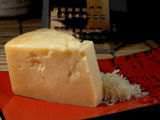Cheddar cheese is a hard English cheese, while Parmesan is a hard Italian cheese. Parmesan has a rich flavor and less aging time while Cheddar cheese is less expensive and has fewer calories.
Comparison chart
History
Cheddar cheese originated in the English village of Cheddar in Somerset, England. It has been produced there since at least the 12th century.
Parmesan cheese was created in the Middle Ages in Bibbiano, Italy.
Traits
Cheddar cheese is a hard, sharp-tasting cheese. Its natural color ranges from pale yellow to off-white, although some manufacturers color the cheese with a brighter yellow. It is slightly crumbly.
Parmesan cheese is hard and granular, with an umami (rich and savory) taste. It is typically straw-colored.
Production
Cheddar cheese is made with cow’s milk. After heating, the curd is kneaded with salt, cut into cubes to drain the whey, then stacked and turned. It is then matured at a constant temperature, e.g. in caves, for 3 to 18 months.
Parmesan cheese is also made for cow’s milk. Whole milk is mixed with naturally skimmed milk, before starter whey is added, and the temperature raised to 33-35 celcius. Calf rennet is then added and left to curdle. The curd is broken into small pieces and left again, before it is collected with pieces of muslin, put into molds, and aged for 12 to 16 months.
Uses
Cheddar cheese is the most popular cheese in the UK and the second most popular cheese in the US. It is used in a huge variety of recipes.
Parmesan cheese is most commonly used in Italian dishes. It is often grated over pasta dishes, stirred into soups and risottos or eaten on its own. It also appears in Caesar salads and is commonly grated onto pizza in the US.
Substitutes
If you do not have access to cheddar cheese, you can use Colby, Cheshire or American cheese instead.
Parmesan can be substituted with asiago, grana padano or romano cheese.
Nutritional Info
Cheddar and Parmesan cheese vary slightly in nutritional values. Both are a good surce of Calcium and iron, have no added sugar, but are very high in saturated fat and sodium. Calories vary based on the type of the milk used (fat/non-fat) for making the cheese.
| Cheddar Cheese (per 100g) | Parmesan Cheese (per 100g) | |
|---|---|---|
| Calories | 403 | 431 |
| Calcium | 95% of daily intake | 111 % of daily intake |
| Iron | 5% of daily intake | 5% of daily intake |
| Fat | 33g | 29g |
| Saturated Fat | 21g | 17g |
| Cholestrol | 105mg | 88mg |
| Sodium | 612mg | 1529mg |
| Carbohydrates | 1g | 4g |
| Protein | 25g | 38g |
Price
Cheese prices vary, but a pound of cheddar currently costs between $4.99 for mild cheddar and $21.99 for extra-sharp 12 year cheddar.
Parmesan costs about $6.89 per pound.
Current prices for Cheddar and Parmesan cheese are available on Amazon.com:
How to make Cheddar and Parmesan at home?
Here are a few interesting videos on how to make Cheddar cheese and Parmesan Cheese at home:
References
- http://en.wikipedia.org/wiki/Cheddar_cheese
- http://en.wikipedia.org/wiki/Parmigiano-Reggiano
- http://www.food.com/library/parmesan-cheese-467
- http://nutritiondata.self.com/facts/dairy-and-egg-products/31/2
- http://nutritiondata.self.com/facts/dairy-and-egg-products/8/2
- http://www.foodsubs.com/Chefirm.html
- http://future.aae.wisc.edu/data/monthly_values/by_area/14
- http://www.bierischeese.com/cheese_varieties.htm






 American Cheese
American Cheese  Bleu Cheese
Bleu Cheese  Edam
Edam  Ale
Ale  Noodles
Noodles  Soy Protein
Soy Protein
Comments: Cheddar Cheese vs Parmesan Cheese